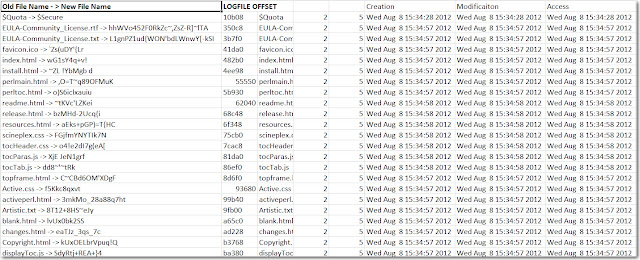Hello Reader!,
It's been awhile since we've talked. Things here at G-C have been pretty busy, the legal sector at least appears to be in a full recovery (knock on wood). While I haven't had time to write up a full blog post on some of the new things we've found over the summer, I did want to take the time to show you how our NTFS $logfile parser is coming. For those of you who attended my CEIC session on 'anti-anti forensics' or who downloaded the labs I posted afterwords you know that we had a rough parser and tests to recover the names of wiped files before.
I'm happy to say we've come a long way since then. The initial proof of concept parser was shown to validate the artifact and divide up the pieces into something we could then further understand. We now have a parser, that is still in development, that can go even further creating CSVs of human readable data extracted from those $logfile segments.
What does that mean? Well it means:
It's been awhile since we've talked. Things here at G-C have been pretty busy, the legal sector at least appears to be in a full recovery (knock on wood). While I haven't had time to write up a full blog post on some of the new things we've found over the summer, I did want to take the time to show you how our NTFS $logfile parser is coming. For those of you who attended my CEIC session on 'anti-anti forensics' or who downloaded the labs I posted afterwords you know that we had a rough parser and tests to recover the names of wiped files before.
I'm happy to say we've come a long way since then. The initial proof of concept parser was shown to validate the artifact and divide up the pieces into something we could then further understand. We now have a parser, that is still in development, that can go even further creating CSVs of human readable data extracted from those $logfile segments.
What does that mean? Well it means:
1. We can recover the names of deleted files and their metadata, even if its been purged out of the MFT. This includes the metadata associated with the file (directory, creation, modification and acess times).
2. We can recover the complete rename operation showing cleanly which file became which file. Including parsing out the directory, creation, modification and access times before and after the operation. This essentially will allow you to undo what a wiper has done (except for recover the contents of the file itself).
3. We can determine if files were written to other drives, and an approximation of how many. (This is not in the current version of the parsers and will require ist own blog post).
4. We can recover the original metadata of a file when it was created.
5. We should be able to recover timestamps that have been altered.
It's all written in perl (woo!) and we are going to release the source and documentation as soon as its ready (tm). In the mean time check out this awesome screenshot showing the parser recovering the metadata from 22 files that were wiped with eraser:
If you are need of this tool for a case immediately drop me a line and I'll see what we can do to help you out!
Also Read: CEIC 2012 - Anti Anti Forensics Materials








awesome and thanks!!
ReplyDeleteGreat work, David!
ReplyDeleteThis is great!! Thanks!!
ReplyDeleteThat is fan-freaking-tastic!!!
ReplyDeleteReally looking forward to using the tool when you release it!
Anxiously awaiting!
ReplyDeleteThis is Excellent...Thanks David!!
ReplyDeleteHello,
ReplyDeleteI have a matter that this would be very helpful with at the moment.
Hey Bryant Overgard feel free to email me for copy now, dcowen@g-cpartners.com
ReplyDelete